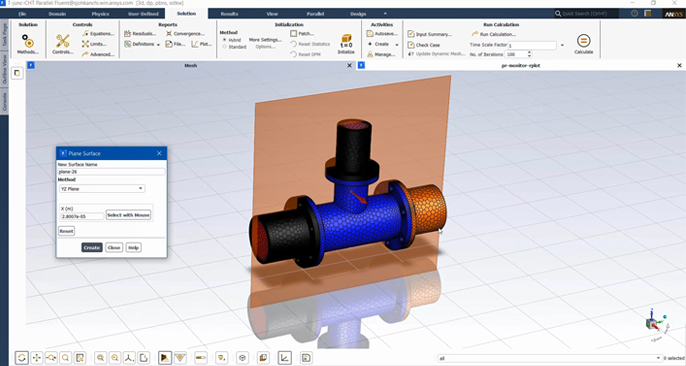
As the need to streamline product development life cycles and improve product performance continues to grow, all engineers in different fields require to acquire the most advanced simulation technologies. Simulation solvers must operate seamlessly across all physics and be accessible to all members of engineering teams for the optimal performance.
From ideation to virtual testing to operation, ANSYS 2020 R1 continues to use ANSYS Minerva integrated simulation throughout the entire product life cycles. This advanced platform can stimulate collaboration within global teams of engineers and promote data sharing to enable product design innovation and reduce development costs.
Minerva unprecedentedly offers one of the most extensive selection of high-precision physics-based simulation software. Moreover, ANSYS 2020 R1 introduces multiple groundbreaking improvements to these technologies, greatly improving engineering productivity.
ANSYS 2020 R1 includes enhancements to ANSYS Mechanical to help engineers design complex, highly nonlinear large models. This release also provides a highly streamlined workflow in ANSYS Fluent, allowing even novice engineers to quickly and easily perform complex multiphase simulations. Other product portfolio upgrades include dynamic new tools for ANSYS HFSS SBR + and ANSYS Maxwell that significantly improve the flow of electronic / electromagnetic design.
|
3D Design
Explore more designs quickly in ANSYS Discovery Live: Change the structural solver to improve the accuracy of simpler geometries and experience the newly introduced steady-state fluid solver. Get upfront design insights by adding manufacturing constraints and multi-analysis optimization for topology optimization capabilities.
With ANSYS Discovery AIM, it’s able to simulate rubber components with an easy-to-use and guided workflow. Structural material data has also been expanded, including orthotropic elasticity and simulation of composite laminates. New automation capabilities in ANSYS Discovery SpaceClaim make it easy to create and modify geometry without the complex traditional CAD systems. Also, the addition minimum surface lattice improves the efficiency of additive manufacturing applications. |
 |
 |
Electromagnetic
ANSYS 2020 R1 provides electromagnetic field simulation solutions to help customers grasp engineering trends in the areas of autonomous driving, 5G connectivity, electrification, and energy efficiency. New features include:
|
|
Embedded Software
In ANSYS 2020 R1, ANSYS SCADE further accelerates the design and automation of code generation for automotive embedded control software that complies with ISO 26262 ASIL D. The ANSYS SCADE kit provides a user-friendly user interface (UI) in the SCADE kit difference module, improving the Simulink® importer, and provides new features for multi-rate and multi-core designs. ANSYS SCADE Test now enables interval inspections and speeds up robustness testing; ANSYS SCADE Vision provides users with a fast way to detect autonomous software (AV) perception software defects by looking for extreme conditions.
Most of the innovations of SCADE toolchain are also available and applicable to aerospace and defense software designers and developers. These innovative products aid shorten the time to achieve DO-178C embedded control software certification and achieve extremely high security. The new version continues to simplify the software design and workflow integration of the embedded avionics cockpit display system and fully covers the ARINC 661 standard. |
 |
 |
Fluids
ANSYS Fluent provides a new experience that enables novice or expert users to run robust computational fluid dynamics (CFD) simulations in less time and with less training than ever. With easy-to-use, task-based meshing workflows and Mosaic technology, complemented by the Fluent CFD solver, you'll get the best results.
Easier to use: More CFD solutions:
|
|
Structures
ANSYS 2020 R1 provides additional enhancements to improve the processing of complex, highly nonlinear, oversized models, allowing ANSYS Mechanical users to enjoy more than ever. Enhancements include:
|
 |
 |
Materials
Accurate materials information is critical for any product development organization, particularly aiming at organizations that are interested in popularizing simulation applications. In ANSYS 2020 R1, ANSYS GRANTA MI improves user experiences and supports the introduction of the gold standard corporate materials information management system across large engineering companies. With GRANTA MI, you can ensure consistency, reduce risk, increase efficiency, and drive innovation.
The new product ANSYS GRANTA MI: Pro is an easy-to-implement, professional version of GRANTA MI designed to provide quick-start options for design and simulation teams. This product allows CAD and CAE users to have direct access to reliable material references in ANSYS GRANTA and a managed list of company-wide materials and their approved attributes. ANSYS 2020 R1 also improves the "GRANTA Simulation Materials Data" data set, which is already available in ANSYS Mechanical and ANSYS Electronics Desktop, and is now available in ANSYS GRANTA MI: Pro. |
|
Systems
ANSYS 2020 R1 includes ANSYS medini analyze for Cybersecurity and new Battery Wizard in ANSYS Twin Builder. ANSYS medini analyze for Cybersecurity provides systematic analysis and assessment of cyber-physical system security threats early in the design phase. Medini analyze also supports safety analysis (SOTIF) of the expected function of the system, making autonomous driving (self-driving cars, air taxis, etc.) possible. With the ANSYS Twin Builder Battery Wizard, you can easily construct battery cells and assemble them into battery modules. It also simplifies model generation and parameterization of ECM cells and modules.
|
.png) |
